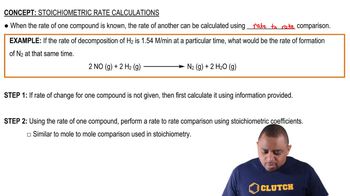At 218°C, 𝐾𝑐 = 1.2×10−4 for the equilibrium NH4SH(𝑠) ⇌ NH3(𝑔) + H2S(𝑔) (a) Calculate the equilibrium concentrations of NH3 and H2S if a sample of solid NH4SH is placed in a closed vessel at 218°C and decomposes until equilibrium is reached.
Ch.15 - Chemical Equilibrium
Chapter 15, Problem 52b
At 80°C, 𝐾𝑐 = 1.87×10−3 for the reaction PH3BCl3(𝑠) ⇌ PH3(𝑔) + BCl3(𝑔) (a) Calculate the equilibrium concentrations of PH3 and BCl3 if a solid sample of PH3BCl3 is placed in a closed vessel at 80°C and decomposes until equilibrium is reached. (b) If the flask has a volume of 0.250 L, what is the minimum mass of PH3BCl3(𝑠) that must be added to the flask to achieve equilibrium?
 Verified step by step guidance
Verified step by step guidance1
Write the expression for the equilibrium constant, Kc, for the reaction: PH3BCl3(s) ⇌ PH3(g) + BCl3(g). Since the solid does not appear in the expression, Kc = [PH3][BCl3].
Set up an ICE (Initial, Change, Equilibrium) table. Assume initially there are no gases, so [PH3] = 0 and [BCl3] = 0. Let x be the change in concentration for both PH3 and BCl3 as the solid decomposes.
At equilibrium, the concentrations will be [PH3] = x and [BCl3] = x. Substitute these into the equilibrium expression: Kc = x^2.
Solve the equation Kc = x^2 for x to find the equilibrium concentrations of PH3 and BCl3. Remember that Kc = 1.87×10^−3 at 80°C.
For part (b), use the ideal gas law PV = nRT to find the number of moles of gas at equilibrium, which is 2x (since x moles of PH3 and x moles of BCl3 are produced). Calculate the mass of PH3BCl3 needed to produce these moles, using its molar mass.

Verified video answer for a similar problem:
This video solution was recommended by our tutors as helpful for the problem above.
Video duration:
3mWas this helpful?
Key Concepts
Here are the essential concepts you must grasp in order to answer the question correctly.
Equilibrium Constant (Kc)
The equilibrium constant (Kc) is a numerical value that expresses the ratio of the concentrations of products to reactants at equilibrium for a given reaction at a specific temperature. For the reaction PH₃BCl₃(s) ⇌ PH₃(g) + BCl₃(g), Kc = [PH₃][BCl₃] / [PH₃BCl₃]. A small Kc value, like 1.87×10⁻³, indicates that at equilibrium, the concentration of reactants is much greater than that of products.
Recommended video:
Guided course

Equilibrium Constant Expressions
Le Chatelier's Principle
Le Chatelier's Principle states that if a dynamic equilibrium is disturbed by changing the conditions, the system will adjust itself to counteract the change and restore a new equilibrium. In this case, adding PH₃BCl₃(s) will shift the equilibrium towards the products, PH₃(g) and BCl₃(g), until a new balance is achieved.
Recommended video:
Guided course

Le Chatelier's Principle
Stoichiometry and Concentration Calculations
Stoichiometry involves using the coefficients of a balanced chemical equation to relate the amounts of reactants and products. To find the equilibrium concentrations of PH₃ and BCl₃, one must set up an ICE (Initial, Change, Equilibrium) table based on the stoichiometry of the reaction and the initial amount of PH₃BCl₃(s) added, considering the volume of the flask to convert moles to concentrations.
Recommended video:
Guided course

Stoichiometric Rate Calculations
Related Practice
Textbook Question
Textbook Question
At 80°C, 𝐾𝑐 = 1.87×10−3 for the reaction PH3BCl3(𝑠) ⇌ PH3(𝑔) + BCl3(𝑔) (a) Calculate the equilibrium concentrations of PH3 and BCl3 if a solid sample of PH3BCl3 is placed in a closed vessel at 80°C and decomposes until equilibrium is reached.
Textbook Question
At 25°C, the reaction CaCrO4(𝑠) ⇌ Ca2+(𝑎𝑞) + CrO42−(𝑎𝑞) has an equilibrium constant 𝐾𝑐 = 7.1×10−4. What are the equilibrium concentrations of Ca2+ and CrO42− in a saturated solution of CaCrO4?
Textbook Question
At 2000°C, the equilibrium constant for the reaction 2 NO(𝑔) ⇌ N2(𝑔) + O2(𝑔) is 𝐾𝑐 = 2.4×103. If the initial concentration of NO is 0.175 M, what are the equilibrium concentrations of NO, N2, and O2?
1
views
